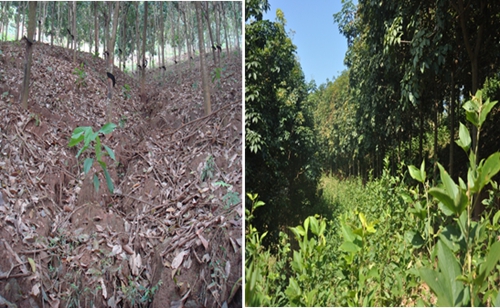In forests, throughfall kinetic energy (TKE) is a widely used indicator to express the potential of rainfall erosivity and predict soil erosion rates. In recent years, the Xishuangbanna local government has proposed building rubber-based agroforestry systems that aim to reduce water and soil losses.
By studying the spatial variability of TKE in the rubber-based agroforestry systems, we can analyze the spatial characteristics of splashing in the forest. Such knowledge would provide a reference for the construction of rubber-based agroforestry systems.
Prof. LIU Wenjie and his students of Xishuangbanna Tropical Botanical Garden (XTBG) conducted a study to estimate the influence of different types of rubber-based agroforestry systems on soil erosion processes. They focused on throughfall kinetic energy under rubber-based agroforestry systems and rubber monoculture.
The researchers experimentally measured TKE and its spatial variability under three different rubber-based agroforestry systems (rubber-cocoa, rubber-F. macrophylla, rubber-tea—orange) and under rubber monoculture. The study was conducted in XTBG under natural rainfall conditions.
The results showed that there were significant linear positive correlations between TKE and rainfall amount. Therefore, the researchers suggest that rainfall was an appropriate and accessible factor for predicting soil loss under rubber plantations in Xishuangbanna.
Although there was no significant difference in TKE under multiple canopies compared to that under monoculture, on average, the ratios of TKE in agroforestry systems were less than that of rubber monoculture. Therefore, to some extent, the construction of agroforestry does reduce soil erosion by TKE.
The effect of rubber-based agroforestry systems in reducing TKE was limited. TKE appeared extreme in areas without the protection of the sub-canopy.
The researchers thus highlight the importance of selecting intercrops and improving intercropping planting patterns for plantation management.
The study entitled “Throughfall kinetic energy and its spatial characteristics under rubber-based agroforestry systems” has been published online in CATENA.
Contact
LIU Wenjie Ph.D Principal Investigator
Key Laboratory of Tropical Forest Ecology, Xishuangbanna Tropical Botanical Garden, Chinese Academy of Sciences, Mengla, Yunnan 666303, China
E-mail: lwj@xtbg.org.cn

Rubber monoculture and rubber-based agroforestry systems in Xishuangbanna
(Images by LIU Jiaqing)

